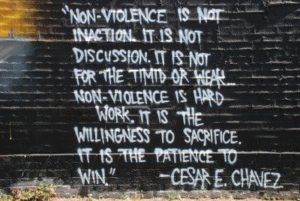
Why do people have to be trained in nonviolence is a frequently asked question. In order to be able to engage in violent encounters one has to train . Violence has many forms, self defence, how to attack an adversary, military training and so on. There are different types of training which prepare you for violence; training in how to fight or defend yourself physically, or using weapons and so on. Each of these forms requires vigorous training . Many today train so that they are able to defend themselves in the event of an attack.
Nonviolence on the other hand seems to be just a topic for discussion as to whether it works or not are the issues which concern people but training in nonviolence is not considered to be a priority. Yet true practitioners of nonviolence will agree that it requires far more rigorous training than training for violence. This is a training that every person should undergo because one never knows when violence can be triggered.
In our violent society today almost every person has a weapon which they carry be it guns, sprays, knives or sticks. It has also been shown that many are fatally wounded by their own weapons when their attackers overpower them and take away their weapons. So is carrying a weapon really a form of defence or “feeling safe”?
We need to change society so that we and our children are really safe.. Acharya Mahapragya in an article on nonviolence and its many facets says, “Social life by its very definition implies a life of interrelatedness … Members of the family and friends do not normally fight with or torment one another. But is this true nonviolence? It certainly is not, for even the slightest case involving selfish interests explodes the relationship.” And he goes on to say that while we can look at the many causes of violence such as stress, nervous disorders, genetic factors, environmental factors and socio economic factors and do something about them, violence will persist unless we look at “developing spiritual nonviolence and basing our life style on it.”
When Mahatma Gandhi took the crucial decision to leave a beautiful house in the centre of Durban to live in a little wood and iron building located in the middle of the bush, with no services on the property or any facilities such as hospitals, schools etc in the neighbourhood, with three neighbours, Rev. Shembe’s Settlement, the Dube family and their Ohlange Institute and the Sugar Estate with its barracks of indentured workers, he consciously adopted a simple life style and changed his mindset or world view and embraced a path of nonviolence.
Clearly this indicates that there is a necessity to make radical mindset shifts and then act on ithem, in order to build a peaceful society.
Mao Ze –Dung said, “war can only be abolished by war.” Does this really make sense? With the advent of weapons of mass destruction the possibility of complete annihilation of countries exists and the question posed is if both parties are destroyed by the war then who will build a future and why will the future be brighter after people have been so brutalised by the war. The strong possibilities of military government exists with little if any hope of a brighter future.
So training for nonviolence is of the utmost importance if we want a peaceful world and a sustainable world. Such training involves a number of areas which address both the issues of the broad socio economic causes of violence and the issues of personal control over anger, stress and other factors that lead to violence. These are issues that need time, patience and concentrated work. Such training should also be taken across the spectrum to many sectors of our society starting from the safety and security cluster to the pre school levels. Such work can be very successful if there is a will right from the top, if there is a very clear programme for long term sustainability and if we can run it with a domino effect from cluster to cluster, broadening and expanding. We invite you to join us in this programme.

